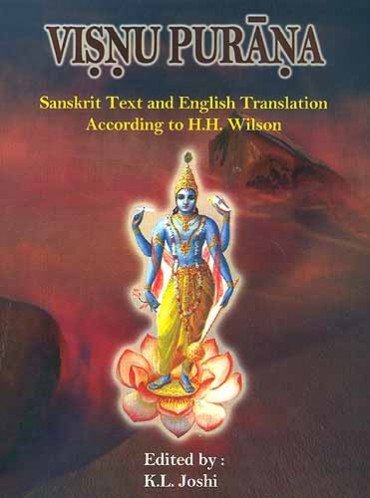The Vishnu Purana
by Horace Hayman Wilson | 1840 | 287,946 words | ISBN-10: 8171102127
The English translation of the Vishnu Purana. This is a primary sacred text of the Vaishnava branch of Hinduism. It is one of the eighteen greater Puranas, a branch of sacred Vedic literature which was first committed to writing during the first millennium of the common era. Like most of the other Puranas, this is a complete narrative from the cr...
Chapter X - Names of the twelve Adityas
Names of the twelve Ādityas. Names of the Ṛṣis, Gandharbhas, Apsarasas, Yakṣas, Uragas, and Rākṣasas, who attend the chariot of the sun in each month of the year. Their respective functions.
Parāśara said:—
Between the extreme northern and southern points the sun has to traverse in a year one hundred and eighty degrees, ascending and descending[1]. His car is presided over by divine Ādityas, Ṛṣis, heavenly singers and nymphs, Yakṣas, serpents, and Rākṣasas (one of each being placed in it in every month). The Āditya Dhātri, the sage Pulastya, the Gandharva Tumburu, the nymph Kratusṭhalā, the Yakṣa Rathakrit, the serpent Vāsuki, and the Rākṣas Heti, always reside in the sun's car, in the month of Madhu or Caitra, as its seven guardians. In Vaiśākh or Mādhava the seven are Āryamat, Pulaha, Nāreda, Punjikāsthalī, Rathaujas, Kacanīra, and Praheti. In Śuci or Jyeṣṭha they are Mitra, Atri, Hāhā, Menā, Rathaswana, Takṣaka, and Paurusheya. In the month Śukra or Āṣādha they are Varuṇa, Vaśiṣṭha, Huhu, Sahajanyā, Rathacitra, Nāga, and Budha. In the month Nabhas (or Srāvaṇa) they are Indra, Aṅgiras, Visvāvasu, Pramlocā, Śrotas, and Elapatra (the name of both serpent and Rākṣas). In the month Bhādrapada they are Vivaswat, Bhrigu, Ugrasena, Anumlocha, Āpūraṇa, Śaṅkhapāla, and Vyāghra. In the month of Āswin they are Pūṣan, Gautama, Suruci, Ghritācī, Sushena, Dhanañjaya, and Vāta. In the month of Kārtik they are Parjanya, Bharadvāja, (another) Visvāvasu, Visvācī, Senajit, Airāvata, and Cāpa. In Agrahāyana or Mārgaśīrṣa they are Ansu, Kaśyapa, Citrasena, Urvasi, Tārkṣya, Mahāpadma, and Vidyut. In the month of Pauṣa, Bhaga, Kratu, Urṇāyu, Purvacittī, Aṛṣṭanemi, Karkoṭaka, and Sphūrja are the seven who abide in the orb of the sun, the glorious spirits who scatter light throughout the universe. In the month of Māgha the seven who are in the sun are Tvaṣṭri, Jamadagni, Dhritaraṣṭra, Tilottamā, Ritajit, Kambala, and Brahmāpeta. Those who abide in the sun in the month Phālguna are Viṣṇu, Visvamitra, Sūryaverccas, Rambhā, Satyajit, Aswatara, and Yajñāpeta.
In this manner, Maitreya, a troop of seven celestial beings, supported by the energy of Viṣṇu, occupies during the several months the orb of the sun. The sage celebrates his praise, and the Gandharva sings, and the nymph dances before him: the Rākṣas attends upon his steps, the serpent harnesses his steeds, and the Yakṣa trims the reins: the numerous pigmy sages, the Bālakhilyas, ever surround his chariot. The whole troop of seven, attached to the sun's car, are the agents in the distribution of cold, heat, and rain, at their respective seasons[2].
Footnotes and references:
[1]:
It might be doubted whether the text meant 180 in each hemisphere or in both, but the sense is sufficiently clear in the Vāyu, &c., and the number of Maṇḍalas travelled in the year is 360: the Maṇḍalas, ‘circles’ or ‘degrees,’ being in fact the sun's diurnal revolutions, and their numbers corresponding with the days of the solar year; as in the Bhaviṣya P. ‘The horses of the sun travel twice 180 degrees in a year, internal and external (to the equator), in the order of the days.’
[2]:
A similar enumeration of the attendants upon the sun's car occurs in the Vāyu, &c. For Yakṣas, the generic term there employed is Grāmaṇīs, but the individuals are the same. The Kūrma and Bhaviṣya refer the twelve Ādityas to different months:—
